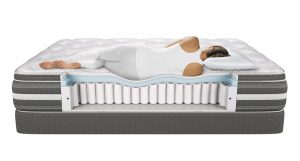(Click Here To download a summarized Mattress Infographic)
Buying a mattress with back pain is a scary task. The number of options seems endless- materials, features, springs, foam, and bases. It can be challenging to determine the right mattress for you. Considering the average adult sleeps eight hours a night, we’re looking at where you may spend a third of your life. This purchase is essential, so our guide broke down some questions you should ask yourself before purchasing a new mattress.
Do I need a new mattress?
The average lifespan of a mattress can range from 5 to 10 years, despite many manufacturers boasting warranties that extend well beyond the 10-year range. Eight years is an excellent mark for most mattresses to consider replacing the bed.
However, if you wake up daily feeling sore or with back pain that tends to resolve within 15-30 minutes of being awake, this could indicate that you should be looking to replace your current mattress.
Unfortunately, there is no one-size-fits-all-all for mattresses. Each of us has a different body type way to sleep, and we rate comfort differently. Some people require a softer mattress, while others prefer a firmer one. In the end, this is a personal preference and very subjective. We will provide you with some general guidelines for your purchase, but there is no replacement for going to the store and testing different options yourself.
We recommend lying on the mattress for at least 10 minutes when testing it. In-person tests are the best indicator of how your body will respond.
Is there a “Comfort Guarantee?”
Another factor to consider when purchasing a mattress is whether your purchase has a comfort guarantee. Even those who have done the highest level of testing can notice mattress imperfections after a few nights’ sleep. Some companies offer a Comfort Guarantee if you are unsatisfied with your mattress. These are often 30-90 days. Every guarantee is different, and some have fees associated with the return. Make sure you understand the fine print associated before making a purchase.
What can I Afford?
It is also essential to understand the cost associated with mattresses. Prices vary widely, ranging from $200 to $5,000 +. Unfortunately, cost does not always correlate with quality or the right mattress for you. You should budget at least $800-1000 for your new mattress. This amount will allow you to purchase a quality mattress that fits your needs and will last 8-10 years.
Innerspring Mattress
The innerspring mattress is also known as a coil mattress. It is the most traditional style of the bed and the most common on the market. These usually come in a firmer mattress style, and the individual coils can offer quality support for your back. The “coil counts” on innerspring mattresses indicate better comfort and support as the number increases. However, once you reach a coil count of 400, the higher count mattresses are generally indecipherable.
Memory Foam Mattress
Memory foam mattresses mold to the contour of your body better than any other type of mattress. The foam results in fewer pressure points while sleeping. These mattresses are softer overall, though some brands can make more firm models. These beds can also absorb movement, decreasing the disturbance of sleeping with a partner. One of the main drawbacks of a memory foam mattress is that it tends to absorb heat, making it a hot night’s sleep.
Latex Mattress
Latex mattresses tend to be firmer, with enthusiastic support throughout their canvas. One of the main features of a latex mattress is that the material remains cooler since the latex does not absorb heat the same way memory foam does. Consider latex mattresses for a patient suffering from low back pain due to their combination of softness and support. Latex mattresses also feel like foam surfaces, similar to memory foam. Another difference is that latex has more bounce, returning to its shape sooner.
Pillow Top
A pillow-top mattress does not indicate a type of mattress but describes adding a soft layer sewn on the bed. They can be any innerspring, latex, or memory foam mattresses underneath the pillow top layer. This option allows a softer, cushioned top surface with a firmer support base.
Adjustable Mattress
Adjustable mattresses can change their firmness from firm to soft at the touch of a button. These options allow you to try different levels of stability until you find the right amount for you. Many of these beds also have adjustable bed angles, which can further customize your sleep experience.
Soft or Firm?
Everyone’s preference is different. However, there are several factors that we can look at to help guide our decision.
The size of the individual sleeping on the mattress is the most critical factor. If you are lighter, a pillow-top bed is not a good fit. To maximize the pillow top, you must be heavy enough to compress the top layer to be supported by the underlying material of the mattress.
You will look for a softer top layer if you are lighter. This allows you to benefit from the lower supportive layer of the mattress. Typically, the denser the top layer, the more uncomfortable a lighter person will be.
You will prefer a denser top layer and a firmer mattress if you are heavier. This is where a pillow top mattress may be a good option. Heavyweight people still looking for that soft feel while they sleep should look for a pillow-top mattress. These will offer a soft cushion with firmer coil support under the top layer.
Sleeping Style
 The following important factor in choosing your mattress style is your sleeping style. Everyone varies from side sleepers to back sleepers to stomach sleepers (although this is not recommended for the health of your back).
The following important factor in choosing your mattress style is your sleeping style. Everyone varies from side sleepers to back sleepers to stomach sleepers (although this is not recommended for the health of your back).
Side Sleepers – recommendations include soft to medium mattresses. The mattress must be gentle enough for you to sink in but offer enough support to prevent pressure points in the back and neck. Your body has curves, and you want your new mattress to support all of those curves while you’re on it.
Back Sleepers – recommendations often include a medium to a firm mattress. The bed must offer adequate support and firmness when sleeping on your back, or you will risk sinking in. This “sunk-in” feeling will flex the spine to increase the likelihood of waking up with back pain.
Stomach Sleepers – these individuals require the most support. Too soft a mattress will cause the napper to sink in and create sleep-associated back pain. If you are a stomach sleeper who regularly wakes up with back pain, we recommend slowly changing your sleep posture to your side or back sleeping. We understand it’s not going to be easy to make a change like this, but it’s the best option for the long-term health of your spine.
These are simple guidelines that help you navigate your next mattress purchase. These are NOT a replacement for physically trying out the mattress yourself. Comfort is always subjective. You won’t know your style preference until you try one for yourself. Remember to take your time when testing. Purchasing the perfect mattress is a financial investment and investment in your long-term health and well-being.
Whether seeking relief from chronic pain or simply aiming for optimal health, your Livonia chiropractor guides you every step of the way. Contact our office to schedule an appointment by Clicking Here or giving us a call today: 734-427-6333

